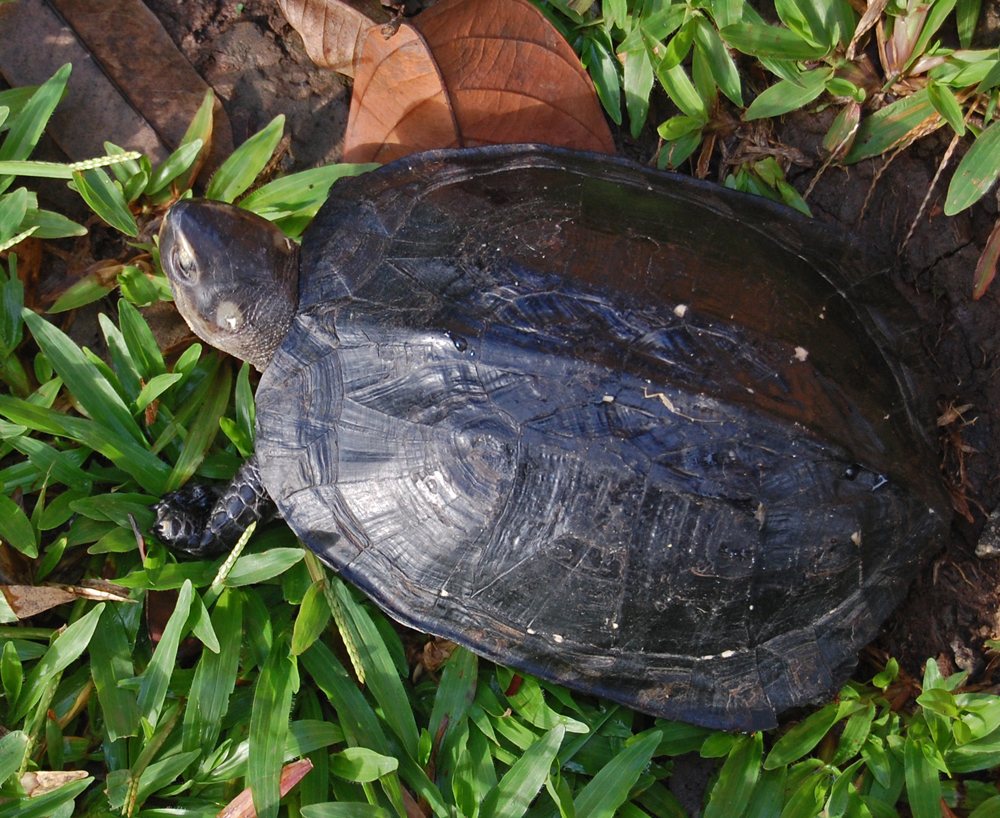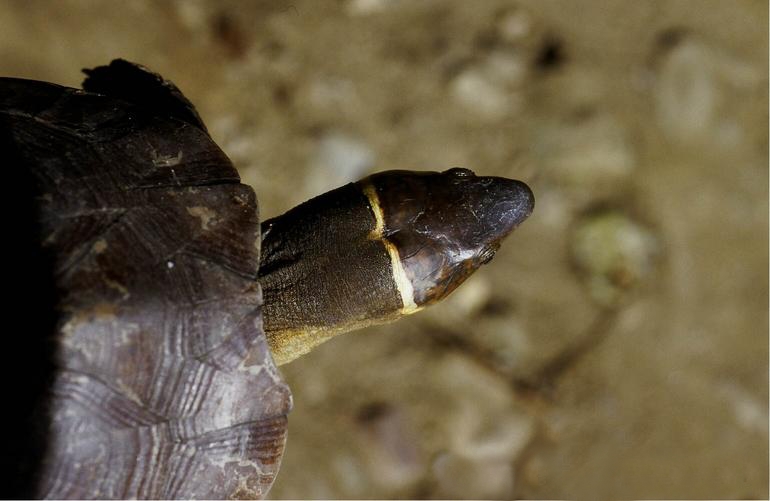|
Siebenrockiella
''Siebenrockiella'' is a small genus of black marsh turtles. It used to be monotypic but now has two species with the addition of the Philippine forest turtle (moved from the genus ''Heosemys''). The genus was originally erected in 1869 by John Edward Gray under the name ''Bellia'', commemorating Thomas Bell, but this name is a junior homonym of '' Bellia'' Milne-Edwards, 1848, a crustacean genus. The replacement name, ''Siebenrockiella'', was published in 1929 by Wassili Adolfovitch Lindholm, and commemorates Friedrich Siebenrock. Species *''Siebenrockiella crassicollis'' (Gray, 1831) – black marsh turtle *''Siebenrockiella leytensis'' (Taylor, 1920) – Philippine forest turtle ''Siebenrockiella leytensis'' is a species of freshwater turtle endemic to the Philippines. It is classified as critically endangered. It is known as the Philippine forest turtle, the Philippine pond turtle, the Palawan turtle, or the Leyte po ... References External links Images at Chelonia.o ... [...More Info...] [...Related Items...] OR: [Wikipedia] [Google] [Baidu] |
Black Marsh Turtle
''Siebenrockiella crassicollis'' (commonly known as black marsh turtle, smiling terrapin, and Siamese temple turtle, among others) is a freshwater turtle endemic to Southeast Asia. It is one of two species classified under the genus '' Siebenrockiella'' in the family Geoemydidae. Black marsh turtles are small to medium-sized turtles that are almost completely black except for white to yellow markings on the head. They are largely aquatic and prefer slow-moving or still bodies of water with heavy vegetation. Black marsh turtles are also commonly kept as pets and as sacred animals in Southeast Asian Buddhist temples. They are classified as endangered by the IUCN, being one of the several Southeast Asian turtle species heavily exploited for the international wildlife trade, particularly for food and traditional medicine in the Chinese markets. Taxonomy and nomenclature Formerly under the genus ''Emys'', black marsh turtles are now classified under ''Siebenrockiella''. They were fi ... [...More Info...] [...Related Items...] OR: [Wikipedia] [Google] [Baidu] |
Philippine Forest Turtle
''Siebenrockiella leytensis'' is a species of freshwater turtle endemic to the Philippines. It is classified as critically endangered. It is known as the Philippine forest turtle, the Philippine pond turtle, the Palawan turtle, or the Leyte pond turtle. Despite the latter common name, it does not occur in the island of Leyte but is instead native to the Palawan island group. It is locally known as ''bakoko'' in Cuyonon. Philippine forest turtles are readily recognizable by their ginkgo-shaped vertebral scutes and a pale white to yellow line traversing across its head behind the ears. The previous characteristic has earned it the nickname of 'bowtie turtle'. Philippine forest turtles are classified under the subgenus ''Panyaenemys''. Together with the smiling terrapin ('' Siebenrockiella crassicollis''), it is one of the two species in the genus ''Siebenrockiella''. Description Philippine forest turtles have brown to reddish brown to black carapaces that reach a length of ... [...More Info...] [...Related Items...] OR: [Wikipedia] [Google] [Baidu] |
Siebenrockiella
''Siebenrockiella'' is a small genus of black marsh turtles. It used to be monotypic but now has two species with the addition of the Philippine forest turtle (moved from the genus ''Heosemys''). The genus was originally erected in 1869 by John Edward Gray under the name ''Bellia'', commemorating Thomas Bell, but this name is a junior homonym of '' Bellia'' Milne-Edwards, 1848, a crustacean genus. The replacement name, ''Siebenrockiella'', was published in 1929 by Wassili Adolfovitch Lindholm, and commemorates Friedrich Siebenrock. Species *''Siebenrockiella crassicollis'' (Gray, 1831) – black marsh turtle *''Siebenrockiella leytensis'' (Taylor, 1920) – Philippine forest turtle ''Siebenrockiella leytensis'' is a species of freshwater turtle endemic to the Philippines. It is classified as critically endangered. It is known as the Philippine forest turtle, the Philippine pond turtle, the Palawan turtle, or the Leyte po ... References External links Images at Chelonia.o ... [...More Info...] [...Related Items...] OR: [Wikipedia] [Google] [Baidu] |
Siebenrockiella Leytensis
''Siebenrockiella'' is a small genus of black marsh turtles. It used to be monotypic but now has two species with the addition of the Philippine forest turtle (moved from the genus ''Heosemys''). The genus was originally erected in 1869 by John Edward Gray under the name ''Bellia'', commemorating Thomas Bell, but this name is a junior homonym of '' Bellia'' Milne-Edwards, 1848, a crustacean genus. The replacement name, ''Siebenrockiella'', was published in 1929 by Wassili Adolfovitch Lindholm, and commemorates Friedrich Siebenrock. Species *''Siebenrockiella crassicollis'' (Gray, 1831) – black marsh turtle *''Siebenrockiella leytensis'' (Taylor, 1920) – Philippine forest turtle ''Siebenrockiella leytensis'' is a species of freshwater turtle endemic to the Philippines. It is classified as critically endangered. It is known as the Philippine forest turtle, the Philippine pond turtle, the Palawan turtle, or the Leyte po ... References External links Images at Chelonia.o ... [...More Info...] [...Related Items...] OR: [Wikipedia] [Google] [Baidu] |
Friedrich Siebenrock
Friedrich Siebenrock (20 January 1853, Schörfling am Attersee – 28 January 1925, Vienna) was an Austrian herpetologist. Biography He studied zoology at the Universities of Innsbruck and Vienna, afterwards serving as a demonstrator under Carl Brühl at the zootomical institute in Vienna. In 1886, he began work as a volunteer at the Naturhistorisches Museum, where he would subsequently spend the remainder of his career. In 1919 he succeeded Franz Steindachner as curator of the amphibian and reptile section at the museum.Naturhistorisches Museum Wien Herpetological Collection His primary scientific research was dedicated to s, pu ... [...More Info...] [...Related Items...] OR: [Wikipedia] [Google] [Baidu] |
Heosemys
''Heosemys'' is a genus of freshwater turtles ("terrapins" in British English) in the family Geoemydidae (formerly called Bataguridae). The genus ''Heosemys'' was split out of the related genus ''Geoemyda'' by McDowell in 1964. Species Four species are placed under ''Heosemys'':Turtle Taxonomy Working Group (Rhodin, A.G.J., van Dijk, P.P, Iverson, J.B., and Shaffer, H.B.).2010Turtles of the world, 2010 update: annotated checklist of taxonomy, synonymy, distribution, and conservation status In: Rhodin, A.G.J., Pritchard, P.C.H., van Dijk, P.P., Saumure, R.A., Buhlmann, K.A., Iverson, J.B., and Mittermeier, R.A. (Eds.). Conservation Biology of Freshwater Turtles and Tortoises: A Compilation Project of the IUCN/SSC Tortoise and Freshwater Turtle Specialist Group. ''Chelonian Research Monographs'' No. 5. pp. 000.85-000.164, * Arakan forest turtle (Boulenger, 1903), ''Heosemys depressa'' * Giant Asian pond turtle (Gray, 1860), ''Heosemys grandis'' * Spiny turtle (Gray, 1831), ''Heo ... [...More Info...] [...Related Items...] OR: [Wikipedia] [Google] [Baidu] |
Bellia
''Bellia picta'' is a species of crab that lives around the coasts of South America, and the only species in the genus ''Bellia''. On the Atlantic coast, it is found in Rio Grande do Sul, Brazil, while on the Pacific coast, it is found off Peru and Chile. It probably lives in burrows and is a filter feeder Filter feeders are a sub-group of suspension feeding animals that feed by straining suspended matter and food particles from water, typically by passing the water over a specialized filtering structure. Some animals that use this method of feedin .... References External links * Crabs Crustaceans of the eastern Pacific Ocean Crustaceans of the Atlantic Ocean Monotypic decapod genera Taxa named by Henri Milne-Edwards {{crab-stub ... [...More Info...] [...Related Items...] OR: [Wikipedia] [Google] [Baidu] |
Junior Homonym
In biology, a homonym is a name for a taxon that is identical in spelling to another such name, that belongs to a different taxon. The rule in the International Code of Zoological Nomenclature is that the first such name to be published is the senior homonym and is to be used (it is " valid"); any others are junior homonyms and must be replaced with new names. It is, however, possible that if a senior homonym is archaic, and not in "prevailing usage," it may be declared a ''nomen oblitum'' and rendered unavailable, while the junior homonym is preserved as a ''nomen protectum''. :For example: :* Cuvier proposed the genus ''Echidna'' in 1797 for the spiny anteater. :*However, Forster had already published the name ''Echidna'' in 1777 for a genus of moray eels. :*Forster's use thus has priority, with Cuvier's being a junior homonym. :*Illiger published the replacement name ''Tachyglossus'' in 1811. Similarly, the International Code of Nomenclature for algae, fungi, and plants (I ... [...More Info...] [...Related Items...] OR: [Wikipedia] [Google] [Baidu] |
Turtle Genera
Turtles are an order of reptiles known as Testudines, characterized by a special shell developed mainly from their ribs. Modern turtles are divided into two major groups, the Pleurodira (side necked turtles) and Cryptodira (hidden necked turtles), which differ in the way the head retracts. There are 360 living and recently extinct species of turtles, including land-dwelling tortoises and freshwater terrapins. They are found on most continents, some islands and, in the case of sea turtles, much of the ocean. Like other amniotes (reptiles, birds, and mammals) they breathe air and do not lay eggs underwater, although many species live in or around water. Turtle shells are made mostly of bone; the upper part is the domed carapace, while the underside is the flatter plastron or belly-plate. Its outer surface is covered in scales made of keratin, the material of hair, horns, and claws. The carapace bones develop from ribs that grow sideways and develop into broad flat plates th ... [...More Info...] [...Related Items...] OR: [Wikipedia] [Google] [Baidu] |
Nomen Novum
In biological nomenclature, a ''nomen novum'' (Latin for "new name"), new replacement name (or replacement name, new substitute name, substitute name) is a scientific name that is created specifically to replace another scientific name, but only when this other name cannot be used for technical, nomenclatural reasons (for example because it is a homonym: it is spelled the same as an existing, older name). It does not apply when a name is changed for taxonomic reasons (representing a change in scientific insight). It is frequently abbreviated, ''e.g.'' ''nomen nov.'', ''nom. nov.''. Zoology In zoology establishing a new replacement name is a nomenclatural act and it must be expressly proposed to substitute a previously established and available name. Often, the older name cannot be used because another animal was described earlier with exactly the same name. For example, Lindholm discovered in 1913 that a generic name ''Jelskia'' established by Bourguignat in 1877 for a European ... [...More Info...] [...Related Items...] OR: [Wikipedia] [Google] [Baidu] |
Crustacean
Crustaceans (Crustacea, ) form a large, diverse arthropod taxon which includes such animals as decapods, seed shrimp, branchiopods, fish lice, krill, remipedes, isopods, barnacles, copepods, amphipods and mantis shrimp. The crustacean group can be treated as a subphylum under the clade Mandibulata. It is now well accepted that the hexapods emerged deep in the Crustacean group, with the completed group referred to as Pancrustacea. Some crustaceans (Remipedia, Cephalocarida, Branchiopoda) are more closely related to insects and the other hexapods than they are to certain other crustaceans. The 67,000 described species range in size from '' Stygotantulus stocki'' at , to the Japanese spider crab with a leg span of up to and a mass of . Like other arthropods, crustaceans have an exoskeleton, which they moult to grow. They are distinguished from other groups of arthropods, such as insects, myriapods and chelicerates, by the possession of biramous (two-parted) limbs, and by th ... [...More Info...] [...Related Items...] OR: [Wikipedia] [Google] [Baidu] |



